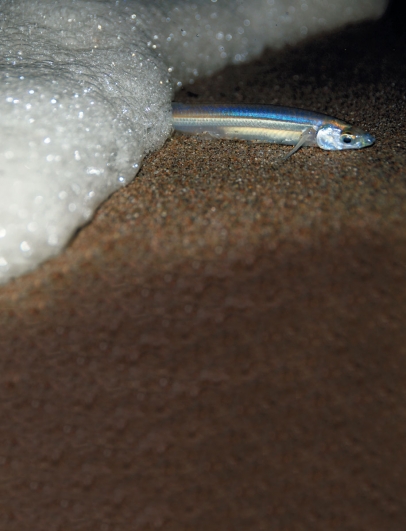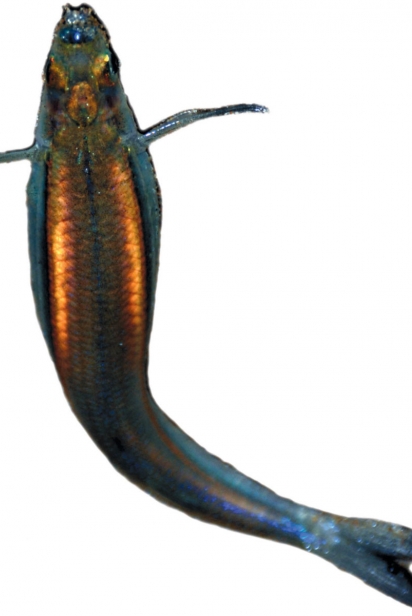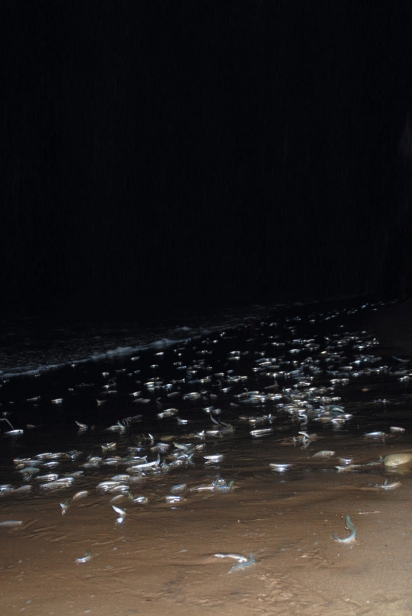Hunting for Grunions
It’s unseasonably balmy on the beach at midnight early in grunion season. I wiggle my toes in the foam from that last wave as I concentrate on the white curl of the next incoming wave, which looks large enough to wash right over my feet.
Do I see moonlight reflecting off a school of silver-sided grunion as the wave crests? Yes! When the wave recedes, the beach is alive with thousands of iridescent sardine-sized fish dancing around my feet, piled so deep I don’t dare move even though they are tickling my ankles. They’ve come to spawn in the moonlight, leave their fertilized eggs in the wet sand at the uppermost edge of the high tide, then ride back into the ocean on the next available wave.
Well, that’s what I thought was going to happen that night on the beach. But what actually happened was … nothing!
Instead, I sat on the sand with my husband, Dave, and some friends waiting for each wave that glistened in the moonlight to deposit a few grunion scouts on the sand. Scouts report back to the gathering grunion that all is clear for a mass spawning, and a full-scale grunion run happens about 20 minutes later. But that night, not one scout appeared.
GRUNION STORIES
I grew up near beaches in Southern California, but I had never actually seen a grunion in spite of many late nights spent on beaches with friends—uh, not that we were actually looking for grunion. In Southern California “going to watch the grunion run” was code for getting permission to stay out late at the beach with friends. For us, grunion were mythical creatures that only parents believed in.
As we sat on the sand at Carpinteria Beach that night under the light of the full moon, we listened to our friends Mark Methmann and Gloria Jimenez talk about grunion runs they’d experienced on this same beach as teens. But then Mark mentioned they’d often tell tourists on the beach that the colorfully lit oil platforms were casinos they could get to by boats waiting at the end of the pier. The longer we waited, the more I embraced the myth theory.
But then this was the first run date of the season and grunion don’t usually run in Santa Barbara until late April, so we knew we were pushing it. We left at half-past midnight.
A few days later, Ben Pitterle, director of Watershed and Marine Programs for Santa Barbara Channelkeeper, assured me that his first large run was at Carpinteria State Beach. He said, “People like to use the term ‘magical,’ and I guess that for lack of anything better, that’s what it feels like.” And fisherman Steve Escobar described the grunion magic he experienced at Port San Luis in the ’80s: “We filled up our pockets and any other containers we could find. They were everywhere.” Convinced that they do exist, I did more research on how to anticipate where a “pop-up” run might occur.
WHERE TO LOOK FOR GRUNION
California grunion (Leuresthes tenuis) are indeed unpredictable and mysterious. During the full and new moons from March through August, they gather off shore at sandy, gently sloping beaches along the California coast between Point Conception and Punta Abrejos, in Baja California. Occasionally, when the water is warm, they are seen as far north as Tomales Bay in Marin.
This is the only time grunion are seen in a group. No one knows where they go when they’re not spawning. They probably spread out to avoid attracting predators.
Runs occur up to two hours after the highest tide on nights just following the full moon or new moon. A grunion run schedule, published by the California Department of Fish and Wildlife, is based on the time of high tide at the Los Angeles Harbor. Ventura high tide is about 10 minutes later, and Santa Barbara is 25 minutes later.
Word is that the second and third nights listed in the schedule are the best.
Which beaches will host a run is unpredictable. Even if you see scouts in a wave at a beach, they may not trigger a run. The likelihood of seeing a spawning run is less than 50% (in my case, apparently far less). Spawning runs can be short and sporadic or can last an hour or more and cover the entire beach. Only about 2% of the runs reach this level.
The majority of the runs (about 90%) are reported along the coast of Los Angeles, Orange and San Diego counties. Spawning activity peaks April through June, with April and May observation-only, no-capture months.
A STEP CLOSER
Research led me to Karen Martin, PhD, a biology professor at Pepperdine University who has done extensive research on grunion. Martin invited Dave and me to join her during the new moon at a surfing beach in Malibu that is popular with grunion.
Right away Martin and some of her students spotted a few Great Blue Heron and Black Crested Night Heron at the water’s edge, watching the outgoing tide for grunion. In the distance we saw them snatch something from the sand and swallow. Martin handed me her night vision scope so I could see my first grunion flipping about the sand at the herons’ feet, easy prey for hungry heron.
We kept our distance because loud noise and flashing light can prevent a run. Perhaps no scouts made it back to give a favorable report because an hour later, there were no more grunion on the beach.
GRUNION GREETERS PROJECT
Martin oversees a group of volunteer “citizen scientists” up and down the coast who report grunion beach activity using an online questionnaire. Anyone can participate; reports of no activity are as important as run data.
A run on East Beach in Santa Barbara was reported the next night—a run we missed.
She put me in touch with a few of her colleagues closer to home. One was Steve Howard, a fisheries biologist who lives in Ventura. Steve offered to meet us at San Buenaventura Beach during the full moon so he could show us what to watch for.
The moon lit a glittered path across the water and onto the sand. As we walked along the water’s edge, we watched for scouts in the surf. I submitted a report of two scouts that night, no run. The next night at Carpinteria Beach, we saw 10 scouts hit the beach, no run.
On the third night the waves were rolling grunion onto the beach when we arrived at East Beach at midnight. Finally, a spawning run! For about 10 minutes 30 to 100 grunion washed up on different parts of the beach.
DO GRUNION REALLY DANCE?
No. Nor do they have feet to run. They flip, flop and appear to leap forward as they come onto the beach and again when they head back to catch a receding wave. Their slender bodies reflect silver-white in the moonlight, flashing like lanterns as they flip. Up close they have iridescent bluish-green backs with silver-blue stripes on the sides. They range from five to seven inches long, depending on age.
They come in on the largest waves of a set, to get as far up the beach as possible. The female digs her tail into the sand. She wiggles in up to her pectoral fins to deposit up to 3,000 bright orange eggs. One or more male grunion arch and curve around her, emitting seminal fluid that travels down her body to fertilize the eggs. While the males head for the next available female, this female wiggles out of the sand and flops back toward the waves. Her work for this moon phase is done. But she may spawn six to eight times per season.
GROWING A GRUNION
Fertilization and incubation take place in the warm, moist sand nest. At first, all that’s visible is the orange yolk of the eggs, which is easy to spot, but will provide the embryo’s food source. Within 12 hours the single cell multiplies to thousands that envelop the yolk, making the egg less visible to predators. At 16 hours, the outline of the embryo is visible and at two days the eyes develop. On day three, the head and tail are moving. On day seven, the fish is ready to hatch.
However, hatching is delayed until the next spawning cycle, when high tide waves reach the nest. The agitation of the water triggers the eggs to hatch as they wash out to sea. If a high tide wave doesn’t reach a nest, the embryos can survive on the yolk up to 35 days, until the next high tide moon phase.
At some aquariums—like the Cabrillo Marine Aquarium in San Pedro—you can experience the hatching process up close. At the beach, you are given a jar with ocean water, a few eggs and a little bit of sand and told to shake the jar gently. The eggs hatch within a couple of minutes. Then you can release them into the receding waves. Your hatchlings will live in the kelp near the shore, eating plankton, for about 40 days before venturing out further into the ocean.
TO EAT OR NOT TO EAT
Less than 1% of the fertilized eggs survive to maturity (one year). Grunion are part of the marine food web. Their eggs are feasted on by shorebirds, beetles, sandworms and some types of flies.
The hatchlings and adult fish are eaten by marine mammals such as dolphins, seals and sea lions. The gathering grunion attract predator fish such as thresher sharks, kelp bass, corvina and croaker. Halibut, guitar fish and squid have been seen following grunion right onto the beach. Heron, snowy egrets and western gulls show up at the water’s edge for grunion appetizers on spawning nights.
Even cats, skunks, raccoons and ground squirrels get into the act. But humans have the most potential impact. Grunion have been gathered and eaten by humans for thousands of years. However, unregulated fishing and the increase in human population put the grunion into decline in the 1920s.
In 1927, seasonal restrictions were established for their protection. Today it is illegal to take any grunion during April and May, their peak spawning period. Although there is no limit, commercial fishing is illegal and anyone over 16 must have an ocean fishing license. It’s illegal to use anything but your hands to collect grunion— no nets or scoops to gather them.
Still the numbers appear to be declining. Beachfront properties, walls and commercial lighting have reduced the amount of beach suitable for spawning. Beach maintenance was a recent concern, but equipment operators now stay above the high tide mark to avoid disturbing the eggs.
Martin is currently studying the population numbers and encourages beach goers to greet—not eat—the grunion they see. She points out that you do not need to buy a fishing license if you are just observing.
OBSERVATION TIPS
Wear warm clothes but expect to get wet. Do not build a fire—flickering light alerts the scouts to danger. Remain still until the wave breaks. Loud noises and lots of activity can cause the grunion to abort or shorten their run. Flashlights also scare the fish, so use them only after the wave recedes. Better yet, allow your eyes to adjust to the darkness. The moonlight reflects off the fish.
And—most important—be patient. Grunion are real and quite magical … just a bit shy.
TO LEARN MORE
California Department of Fish and Wildlife
An expected grunion run schedule is at DFG.ca.gov/Marine/GrunionSchedule.asp
Grunion Greeters Project
Information on volunteer programs and other information is at Grunion.org
Cabrillo Marine Aquarium
Meet the Grunion program is under ‘Education’ at CabrilloMarineAquarium.org
Birch Aquarium, Scripps, UC San Diego
Grunion Run information is under ‘Education’ and ‘Public Programs’ at Aquarium.UCSD.edu
Venice Oceanarium
Check ‘Events’ for grunion parties at VeniceOceanarium.org
VENTURA COUNTY BEACHES
There is no guarantee of a run in a specific area of any beach. They like sandy (not rocky) beaches with a gentle slope and rolling waves. They often show up near freshwater outlets such as rivers, creeks and storm drains and where the beach curves so the waves converge with a swirl.
Check out the beach during the day to see if parking will be available nearby at night. For more information on specific beaches go to CaliforniaBeaches.com/central.
Emma Wood State Beach
West Main and Park Access Rd., Ventura
Harbor Cove Beach
1950 Spinnaker Dr., Ventura
Hollywood Beach
Ocean Dr. and La Granada St., Oxnard
La Conchita Beach
West Surfside St., La Conchita
Mandalay State Beach
Harbor Blvd. and 5th St., Oxnard
McGrath State Beach
2211 N. Harbor Blvd., Oxnard
Mussel Shoals Beach
Ocean Ave. and Breakers Way, Ventura
Oxnard Beach Park
1601 S. Harbor Blvd., Oxnard
Port Hueneme Beach Park
550 Surfside Dr., Port Hueneme
San Buenaventura State Beach
901 San Pedro St., Ventura
Seaward Avenue Beach
S. Seaward Ave., Ventura
Silver Strand Beach
2525 Ocean Dr., Oxnard
Surfer’s Knoll Beach
1596 Spinnaker Dr., Ventura
Ventura Pier Beach
450 E. Harbor Blvd., Ventura
Nancy Oster believes in grunion magic and plans to spend many more late nights waiting for that really big run.







